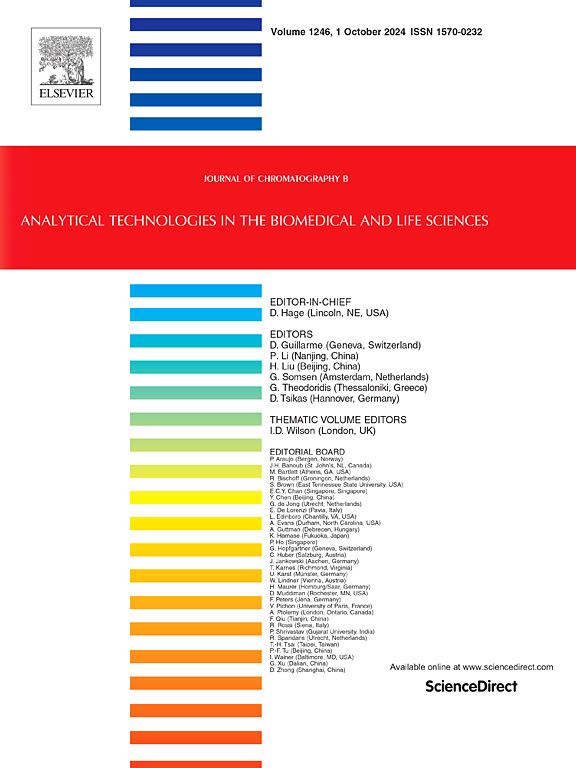Discrimination of isomeric dihydroflavone and chalcone by the boosting optimal collision energy-liquid chromatography-tandem mass spectrometry: A case study of pharmacokinetics in honey-fried licorice
IF 2.8
3区 医学
Q2 BIOCHEMICAL RESEARCH METHODS
引用次数: 0
Abstract
The occurrence of isomeric dihydroflavone and chalcone, two important subfamilies of flavonoid class, extensively happens in herbal medicines. However, identical MS/MS spectra make the identity confirmation a tough job, the complexity will be further boosted in biological samples. Inspired by that isomers possess distinct inherent physicochemical parameters, optimal collision energy (OCE), which is positively correlated with the bond dissociation energies (BDEs), was evaluated towards differentiating isomeric dihydroflavone and chalcone. It was achieved by plotting their relative response-collision energy curves (RRCECs) and comparing the unique OCEs obtained. As a result, difference were observed for either OCE of bond dissociations involving Retro Diels-Alder (RDA) reaction as well as glycosidic cleavage when comparing two pairs of isomers, which were liquiritin vs. isoliquiritin and liquiritigenin vs. isoliquiritigenin, because the energies required for bond dissociation to produce identical fragment ions varies among isomers. Furthermore, OCEs consistently ranked dihydroflavone higher than chalcone, aligning with their BDEs determined through quantum calculation. These results suggested great potential for OCEs in distinguishing between dihydroflavone and chalcone. By applying the discriminating criterion, successful identity recognition was achieved for the two pairs of isomers among the many signals sharing identical MRM transitions in honey-fried licorice treated plasma. Thereafter, the confidence-enhanced OCE-LC-MS/MS method was applied to characterize and determine these 4 isomers along with 3 components of honey-fried licorice in rat plasma, the definite determination as well as the pharmacokinetic courses were subsequently accomplished and discussed. Overall, this study boosted the application of OCE-LC-MS/MS in isomers discrimination of isomeric dihydroflavone and chalcone.
增强最佳碰撞能-液相色谱-串联质谱法鉴别异构体二氢黄酮和查尔酮:以蜂蜜炒甘草中的药代动力学为例
异构体二氢黄酮和查尔酮是类黄酮的两个重要亚科,广泛存在于中草药中。然而,相同的MS/MS谱使鉴定工作变得困难,在生物样品中进一步增加了鉴定的复杂性。由于同分异构体具有不同的内在物理化学参数,本文利用最佳碰撞能(OCE)与键解离能(BDEs)之间的正相关关系,对二氢黄酮和查尔酮的同分异构体进行了判别。通过绘制它们的相对响应-碰撞能量曲线(RRCECs)并比较得到的唯一能量曲线来实现。结果,当比较两对异构体(甘草素与异甘草素、甘草素与异甘草素)时,观察到涉及Retro Diels-Alder (RDA)反应的键解离的OCE以及糖苷解离,两者都存在差异,因为不同异构体产生相同片段离子所需的键解离能量不同。此外,oce始终将二氢黄酮排在查尔酮之前,这与量子计算确定的bde一致。这些结果表明,OCEs在区分二氢黄酮和查尔酮方面具有很大的潜力。应用该判别准则,成功地对蜂蜜甘草处理血浆中具有相同MRM过渡的信号中的两对异构体进行了身份识别。随后,采用置信度增强的ce- lc -MS/MS方法对这4种异构体及3种蜂蜜炒甘草成分在大鼠血浆中的含量进行了表征和测定,并对其药代动力学过程进行了分析和讨论。本研究促进了ce - lc -MS/MS在二氢黄酮和查尔酮异构体鉴别中的应用。
本文章由计算机程序翻译,如有差异,请以英文原文为准。
求助全文
约1分钟内获得全文
求助全文
来源期刊

Journal of Chromatography B
医学-分析化学
CiteScore
5.60
自引率
3.30%
发文量
306
审稿时长
44 days
期刊介绍:
The Journal of Chromatography B publishes papers on developments in separation science relevant to biology and biomedical research including both fundamental advances and applications. Analytical techniques which may be considered include the various facets of chromatography, electrophoresis and related methods, affinity and immunoaffinity-based methodologies, hyphenated and other multi-dimensional techniques, and microanalytical approaches. The journal also considers articles reporting developments in sample preparation, detection techniques including mass spectrometry, and data handling and analysis.
Developments related to preparative separations for the isolation and purification of components of biological systems may be published, including chromatographic and electrophoretic methods, affinity separations, field flow fractionation and other preparative approaches.
Applications to the analysis of biological systems and samples will be considered when the analytical science contains a significant element of novelty, e.g. a new approach to the separation of a compound, novel combination of analytical techniques, or significantly improved analytical performance.
 求助内容:
求助内容: 应助结果提醒方式:
应助结果提醒方式:


